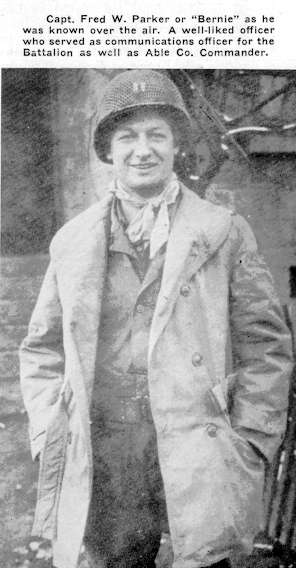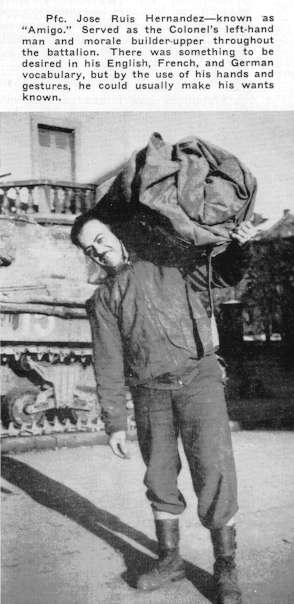Brittany |
Table of Contents |
Nancy |
Brittany |
Table of Contents |
Nancy |
With
the famous break-through to Brest over, and the Battalion refreshed from
the succeeding rest at Plouvien, Higher Headquarters didn't waste any time
in picking another job for us. The Division was ordered to the vicinity
of Lorient, which had been reached by the Fourth Armored Division almost
abreast of us. We were to relieve them, and from what we had heard they
needed it. Well, anyway we left Plouvien on the thirteenth of August, and
headed toward Lorient. We arrived at Le Heles later in the day, and bivouacked
there for the night.
The Battalion Staff and Company Commanders left the Battalion area the next morning and went forward to reconnoiter the area held by the 8th Tk Bn., 4th A.D., preparatory to relieving them. Then, at 1600 the battalion moved out of its bivouac area and closed in the vicinity of Arzano at two o'clock the following morning.
Then, we were relieved from being attached to CCA, and were attached to CCB. Our mission was to contain Lorient, in support of the 44th Armored Infantry Battalion and elements of the 25th Armored Engineer Battalion.
On the sixteenth of August, while the Battalion remained in bivouac near Arzano, Col. Davall, his S-2, Assault Gun Platoon Leader, Reconnaissance Platoon, and one platoon of light tanks from "D" Company departed on a reconnaissance in force to the east. The mission was to determine the number and disposition in the area generally between Vannes and Nantes and to sever the main road between those two cities, The patrol reached Vannes in the late afternoon, contacted elements of a French Paratroop Regiment and went into bivouac there for the night. The S-3 returned to Division with the information gained from the French, and rejoined the force before midnight.
On the following day, while the battalion's status remained unchanged, the reconnaissance force continued on its mission. They found the bridge at La Roche Bernard blown, and they continued to the east generally along the axis of the River. When they reached Redon, only, peeps could cross the flimsy bridge, so the rest of the force remained in assembly west of town. At Fegreac, element of the patrol drew small arms and machine gun fire, and lost one casualty; other elements of the patrol went on to Bloin and contacted a friendly cavalry group there. No feasible bridges nor crossing sites were found between La Roche Bernard and Bloin, so the patrol reassembled. Mission accomplished, they started back, and Col. Davall proceeded directly to Major General Grow at Division Headquarters, to report on all the information he had obtained.
The returning patrol found the rest of the battalion in the same place, with its status unchanged; and so it remained until on the twentieth of August, "A" Company was detached from the Battalion with a separate important mission connected with the reduction of Brest, and so, under orders from Higher Headquarters, they proceeded ninety miles overland to the vicinity of Landerneau, and went into bivouac there.
While "A" Company was moving toward the Daoulas peninsula, Companies "B"
and "C," and the Medics proceeded to the rear area north of Arzano and
established a rear bivouac for training purposes.

Things
were getting pretty quiet; Jerry, cooped up in his snug little fortifications
in Lorient, realizing he wasn't going anywhere in a hurry, and we, on the
other hand were only supposed to contain the city. But, while the remainder
of the battalion enjoyed the comparative peace and quiet, our recon platoon,
under Lt. Linebaugh, made daily trips to reconnoiter areas west of the
River. Col. Davall generally went along with the patrol, and observed from
little La Pouldu the various kraut activities on the other side of the
river over near Lorient. And so it went until the 28th of August.
However, while the above activities were taking place at Lorient, “A” Company up on the Daoulas peninsula was taking part in quite a scrap. For, on August 25th they jumped off in support of foot slogging sad sacks in the attack on Daoulas peninsula in an attempt to secure more advantage ous positions for the artillery siege of Brest. On the 26th they were assigned the objective of Lesquivet, and attained this objective at 1730 after a bitter fight; the next day, without respite, and forced to forage for supplies, they continued their attack with Plougastel as the objective. An interesting sidelight on this action was related by Captain Polk: It seemed that in the heights of the melee, he found himself in front of a huge wine and cognac store. However,. he was too busy mowing down krauts to thoroughl y investigate the store, but he vowed that at the earliest practicable moment he would return to reap the fruits of a hardwon victory. He returned some time later, after be and his men had erased all opposition , only to find that some atrocity committing enemy artilleryma n had zeroed in on the building and left nothing but broken bottles. The following day “A” Company was employed to bring direct fire on Brest installation s; in so doing they found that every time they moved up on the overlookin g heights to fire they became the target of practically every gun in the fortress. But this did not phase [sic] the Polkmen and they caused destructio n until their ammunitio n gave out. It must be admitted that this company was assigned missions for which it was not suited, and although performed under stiff protest, each one wassuccessful in spite of the handicap of working with the commanders who were not too familiar with armored operations.
On August 29th, the remainder of the battalion at Lorient relieved the 44th AIB and occupied dismounted defensive positions with the mission of containing that portion of Lorient within its zone. We must mention here that this was the first time the tankers were called upon to function as doughs, and that we were not particularly well set-up for such an operation, as our small arms consisted of Tommy guns and Carbines for the most part of short range, and very few dismounted automatic weapons.
Captain
Williford D. Bland was placed in command of the forward CP. and had the
following troops under his command: his "B" Company tankers (dismounted),
Company "A" of the 25th Engineers, Company "A" of the 9th AIB, Mortar Platoon
68th, and elements of Headquarters Company of the 68th. A regular infantry
OPL was set up, complete with wire communications, and booby traps and
other warning devices ringing forward outposts. The line ran generally
from Pont Scorff to just short of Quimperle, the outposts were set up on
dominant hills, and No Man's Land was wooded, ravined, and observation
was poor except from these high points. Jerry would send out small routine
foraging and reconnaissance patrols, but never in considerable strength.
The men had orders not to fire except when absolutely necessary, and often
heinie patrols would come as close as fifty yards from OP's and yet our
well concealed positions were not disclosed. But Jerry knew darn well that
we were there somewhere, and didn't try to come too far. Discipline and
training, learned in garrison, was now paying off.
 All
this time, our Reconnaissance Platoon made daily patrols west of the river,
combining excellent training with practical observation of German positions,
and the Assault Gun Platoon fired many successful indirect fire missions
to the great delight of its leader, Lt. Hickerson, and to the obvious dismay
of the Krauts. Later on, Company "D" gave the Recon Platoon a much needed
relief on these patrols, and for the first ten days in September, operations
went on much the same as previously, with companies successively taking
their turns on the OPL. On the 11th, there was a great deal of activity
around the outposts, and five enemy prisoners were taken. Perhaps it was
due to the presence of elements of the 94th Infantry Division, was prepared
to relieve us of our sectors and Jerry sensed that there was some sort
of a change taking place. We have omitted one separate action which should
be mentioned before we pass on to the next phase. On August 5th, the enemy
launched an attack in the direction of outpost 14 at 1420, and by 1450
had succeeded in outflanking and cutting off the OP. This outpost, commanded
by 1st Lt. Thomas Hill, held fast, and with the aid of our artillery we
were able to drive back the attackers, causing many enemy casualties; our
losses were one dead and two wounded. Our Battalion Surgeon, Captain Duane
H. Callister was seriously wounded in the back while attempting to go forward
to the aid of a wounded Jerry; he was hit by enemy mortar fire.
All
this time, our Reconnaissance Platoon made daily patrols west of the river,
combining excellent training with practical observation of German positions,
and the Assault Gun Platoon fired many successful indirect fire missions
to the great delight of its leader, Lt. Hickerson, and to the obvious dismay
of the Krauts. Later on, Company "D" gave the Recon Platoon a much needed
relief on these patrols, and for the first ten days in September, operations
went on much the same as previously, with companies successively taking
their turns on the OPL. On the 11th, there was a great deal of activity
around the outposts, and five enemy prisoners were taken. Perhaps it was
due to the presence of elements of the 94th Infantry Division, was prepared
to relieve us of our sectors and Jerry sensed that there was some sort
of a change taking place. We have omitted one separate action which should
be mentioned before we pass on to the next phase. On August 5th, the enemy
launched an attack in the direction of outpost 14 at 1420, and by 1450
had succeeded in outflanking and cutting off the OP. This outpost, commanded
by 1st Lt. Thomas Hill, held fast, and with the aid of our artillery we
were able to drive back the attackers, causing many enemy casualties; our
losses were one dead and two wounded. Our Battalion Surgeon, Captain Duane
H. Callister was seriously wounded in the back while attempting to go forward
to the aid of a wounded Jerry; he was hit by enemy mortar fire.
On September 13th, the 301st Infantry Regiment relieved our outposts by infiltration. All our units came off the line and moved to a rear area, preparing to march to Orleans where we were scheduled to be refitted and rested. One Platoon of Company "D" under Lt. Siedentop was attached to elements of the 86th Cavalry Reconnaissance Squadron, and the remainder of the battalion moved out at 1330 toward Orleans, and bivouacked that evening in the vicinity of Augan.
"A" Company, relieved from the Task Force at Brest on the 6th, had moved out by a separate route and already was at Orleans. On the 14th, the battalion continued the road march having traveled a distance of a hundred and sixteen miles. The next day, we reached the Orleans area, and work began on vehicles, weapons, and equipment. Entertainment was furnished for the men, and passes to Orleans and nearby Montargis were issued. Captured Wehrmacht wine and cognac was distributed. Morale was sky-high.
NOTE: Remove question mark from address below when sending email
This page is maintained by Bruce Frederick, EMAIL
.
Last updated: June 12, 1999.